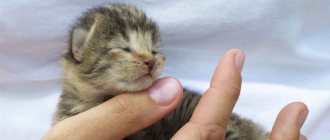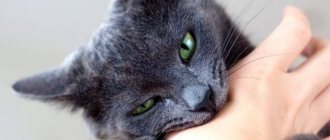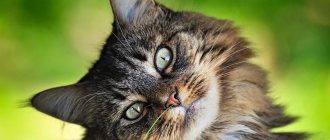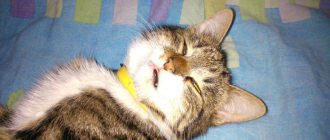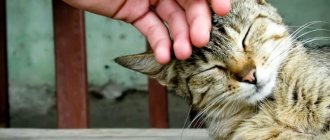How to pet a cat correctly?
There are certain points on the human body, pressing on which during a massage allows you to relieve stress from the muscles and get maximum relaxation of the body. Your pets are no exception to this situation. They also have certain areas on the body, massaging which even the most stubborn representative of the breed will not remain indifferent.
Neck and ear area
Ears are a favorite place for petting dogs and cats. Try the following steps and you will see your pet’s grateful eyes:
- Using gentle massaging movements with your fingers, stroke the kitten in the ear area.
- Smoothly move from the center to the edges of the ears.
- Slowly lower yourself to the back of your head and massage with gentle movements.
From such caresses your pet will simply stretch out in bliss.
Neck, chest and chin area
The animal cannot properly scratch these areas of the body with its paws, so most cats love it when their owners give these areas a gentle massage. If you adhere to the following recommendations, you will see in practice that you are now petting your cat correctly:
- Use your fingertips to follow your pet's chin. Notice how he stretches his neck forward in pleasure.
- Slowly, going through the fur, go down to the chest area.
Important! Movements and pressures should not be sharp or intense, so as not to damage the animal’s larynx.
Back area
Since the cat family walks on four legs, the entire load from their movement goes to the spine. Therefore, they often develop a disease of this part of the skeleton.
If your cat falls asleep on your lap, help her feel completely relaxed and cared for:
- Pet your pet from the neck to the base of the tail.
- Using light pressure with your fingertips, move from the back of the head to the base of the tail along the spine to relieve tension from the back.
Important!
When petting, try not to touch the tail, as cats do not like this. Rest assured, this is the correct way to pet a cat.
Cheek area
Want to cheer up your kitten? Caressing the cheeks for this, as with a person, is best suited:
- When the animal is calm, use gentle touches to stroke the area under the animal's eyes.
- Smoothly move to the cheeks - they are located behind the whiskers in cats.
In response to your actions, you will hear the cat’s satisfying purr.
How not to pet cats?
There are certain moments when you give the “purr” not pleasure, but rather discomfort from caresses. Therefore, every cat owner needs to know how and when not to pet their pet, so as not to irritate it:
- Have you noticed how a cat winces when you run your hand against the fur? Representatives of the cat family do not like such stroking on your part, so you should not do this in the future.
Important! Short-haired cats may experience pain from stroking against the grain.
- Cats and cats are very gentle creatures. Therefore, when you caress your pet, you should not make much effort, put too much pressure on the spine or make the caresses rough.
- If your cat has done something wrong, do not pet him immediately after punishing him. He may perceive such actions as encouragement and continue to do dirty tricks in the future.
- You should not often bother your animal with affection. The exception is situations when he himself insists on stroking.
Cats do not understand human language, and to explain to them how much you love your pet, you should use another language - affection. Determine the areas from which your pet gets the most pleasure from stroking and, if possible, pet him. In return, you will receive even more love and pleasant, soothing purrs from your cat.
How and where to stroke a cat so that they like it: in what places, is it possible to stroke against the grain and why do they not allow you to stroke their belly, how to find an approach to an unfamiliar cat.
Even those people who do not have pets have petted a cat at least once in their lives. And, most likely, they didn’t do it exactly the way she liked.
It is best to pet the cat in those places where its scent glands are concentrated.
. When a person touches these areas of fur, the skin underneath secretes a secretion that remains on the hands. In this way, the cat marks its owner, which makes him happier and more confident.
The most sensitive areas of cats
The favorite places for stroking are those areas of the cat's body where the aforementioned “odorous” glands are located, or rather those where there are the largest number of them. For this reason, the most “pleasant” places are:
- The middle of the forehead located between the ears.
- The area located between the ear and eye. This area in cats is somewhat “bald” due to the sparser fur than on the rest of the body. Moreover, it is rarer not only in adults, but also in small kittens. It is assumed that this is where the maximum number of “scent” glands are located, with which the cat marks its property.
- Angle between nose and lips. These are the very places where cat whiskers grow. This is the area where a cat most often rubs against household furniture and its owner’s legs.
- Lips and chin: scratching these places gives cats the most pleasure.
- The lower part of the back located at the base of the tail.
What areas are most sensitive in cats?
There are no scent glands on the abdomen, but this area is very sensitive to touch. And only if the pet has maximum trust in its owner will it lie on its back and allow it to stroke its belly.
How often does heat occur?
As mentioned earlier, the average frequency is about 3-4 times a year. However, experts assure that a cat is not always ready for offspring from a physical point of view. She should not be allowed to bring kittens more than 2 times a year. Ultimately, the pet will run out of strength, it will wither and die completely by the age of 3-4 years.
How to determine heat
The determination process is quite complicated for those who have just become pet owners. To be sure that a cat is in heat, you need to know the features that are associated with the physiology of felines. For example, many people are not even aware of such a fact as “cyclicality”. It is worth paying attention to the following information:
- The pre-temperature period lasts approximately 3 days. Already at this stage, you can immediately tell that the cat is about to begin to behave differently than before. This shows a strong attachment to the owners, loss of interest in games and food. In rare cases, aggression is observed and the genitals swell. If the owner plans to get offspring, then pre-breeding is not the best period for mating. Everything is simple here: the cat simply will not let the male near, but during this period she begins to “shit” a lot in the corners;
- Estrus is the period of estrus itself, lasting on average from 7 to 10 days, it all depends on the breed and weight category of the pet. During this period, you need to be extremely careful, the cat is in the mood to “hunt” (to find a partner), so it can easily run out of an open door or slip through the windows from its owners. This period is characterized by: standing in a pose, loud meowing, excessive affection. Speaking about the internal component, during this period the follicles reach a state of maximum development and are ready to leave the egg. The main thing is not to let it on the bed, as the discharge is difficult to wash off. The pet will meow a lot, you need to try to distract it;
- post-estrus - here a false pregnancy can occur, which you need to be able to identify, or a real pregnancy if the cat managed to escape in search of adventure. The cat's behavior calms down, becomes more irritable, and tries to run away. During this period, if you just need to monitor your pet, in case of gland swelling, you should contact an experienced veterinarian. False pregnancy has a very negative effect on the psyche; the cat may begin to hide or be aggressive towards members of the household;
- enestrus is the period between estrus. On average, this is 4-5 months; if the period falls in winter, it can last up to 6 months. Hormones are produced minimally, the cat behaves normally.
In addition to tablets, drops and traditional methods of eliminating the problem, you need to know about others:
- Sterilization is a good way to resolve the issue; most importantly, it completely stops estrus and completely rids the cat of diseases of the reproductive system. In simple terms, your pet has a better chance of living a healthier, longer life. After removal, you can forget about the kittens, as well as the constant screaming;
- mating - on average, a cat can give birth 3 times in 1 year. If the owner does not plan to deal with the kittens that much, then it is better to use the first option. Moreover, pregnancy greatly depletes the body, even if the cat has already given birth this year and seems thin, her instincts will not stop her from doing it again. You can calm it down using the techniques above.
Important! Correct identification of symptoms will make it possible to minimize the consequences.
The above information will help you figure out what to do if a cat wants a cat and screams, how to calm it down at home. You can use medications and traditional medicine. The main thing is to treat the cat carefully and carefully during the period when it requires a cat.
A cat in heat causes a lot of trouble to its owners. If a cat asks for a cat, she can be calmed at home without resorting to sterilization. To do this, you can use folk remedies and special preparations.
Long sleep
Cats sleep up to 20 hours a day; they need such long sleep in order to gain strength for hunting. Of course, domestic animals no longer need to hunt, and prey does not run around the apartment, but ancient instincts still make themselves felt.
Cats love to sleep curled up in a ball or stretched out at full length, and not be disturbed by anyone. If there are small children in the house who constantly disturb the purring sleep, then the animal can become nervous, aggressive and may even get sick. Sometimes it seems that the pet is sleeping even while sitting, but in fact he is only dozing lightly and is on alert.

